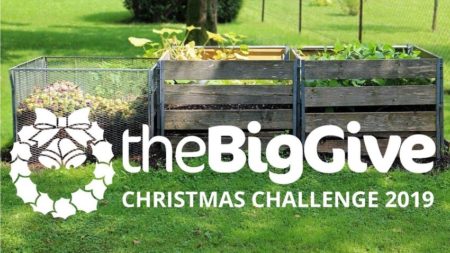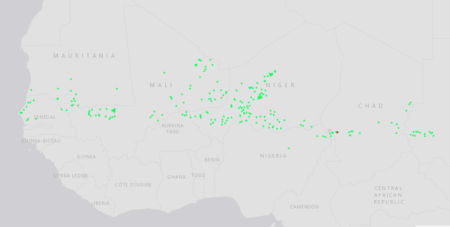- Impacts of Global Food Systems on Biodiversity and Water: The Vision of Two Reports and Future Aims. It’s all connected, and not in a good way.
- On‐Site Capabilities of a Mobile Laboratory for Aquatic Germplasm Cryopreservation. Not so easy for plants, alas.
- Biogeography and conservation status of the pineapple family (Bromeliaceae). The Atlantic Forest, the northern Andes and Central America.
- A review of types of risks in agriculture: What we know and what we need to know. Very few studies look beyond production risk, largely ignoring four other types of risk, and the prevalence of multiple risks.
- Visual and olfactory floral cues related to ambophilous pollination systems in Poaceae. Insects can facilitate pollination in some grasses.
- Cassava Trait Preferences of Men and Women Farmers in Nigeria: Implications for Breeding. Women select on quality, men on agronomy.
- Phenotypic and physiological responses to salt exposure in Sorghum reveal diversity among domesticated landraces. Salinity tolerance was acquired early in domestication and then maintained or lost depending on prevalent soil conditions.
- Combining Focused Identification of Germplasm and Core Collection Strategies to Identify Genebank Accessions for Central European Soybean Breeding. Pre-core FIGS subset based on adaptation to high-latitude cold regions, followed by coring using genotype data: from >17,000 to 366 accessions.
- Adaptive introgression during environmental change can weaken reproductive isolation. Reverse speciation is upon us.
- The future of legume genetic data resources: Challenges, opportunities, and priorities. Centralize and standardise. Good luck with that.
- Application of Mixed Methods to Identify Small Ruminant Disease Priorities in Ethiopia. National disease controls programmes may be on the wrong track.
- Tartary buckwheat (Fagopyrum tataricum Gaertn.) landraces cultivated by Yi people in Liangshan, China. 13 landraces, but not very well differentiated as to use.
- The draft genome of a wild barley genotype reveals its enrichment in genes related to biotic and abiotic stresses compared to cultivated barley. More genes, more alleles in known genes.
- The endemic ‘sugar canes’ of Madagascar (Poaceae, Saccharinae: Lasiorhachis) are close relatives of sorghum. Closer than some actual Sorghum spp.
- Large genetic yield potential and genetic yield gap estimated for wheat in Europe. Long way to go to match the potential, modelled yield of ideotypes.
Brainfood: Diversification, Chefs, African rice breeding, Sustainable livestock, Miscanthus origin, Sweetpotato diversity, Wild banana seeds, Olive diversity, Tilapia diversity, Half Earth, Food access, Speedy pigeonpea, Peanut allergy, Colombian seed saving
- Modelling crop diversification and association effects in agricultural systems. Intercrop, people!
- Cooking up Diverse Diets: Advancing Biodiversity in Food and Agriculture through Collaborations with Chefs. Yeah, yeah, chefs are great. Now show me the data.
- Multivariate analysis and selection criteria for identification of African rice (Oryza glaberrima) for genetic improvement of indica rice cultivars. Go for high number of productive tillers and early maturity.
- Strategies for Sustainable Use of Indigenous Cattle Genetic Resources in Southern Africa. Not just genetic improvement: also need better nutrition, healthcare, marketing, and infrastructure; integration and empowerment of women and youth; and capacity building, regulatory, and policy frameworks. Not unlike crops, really.
- Population structure of Miscanthus sacchariflorus reveals two major polyploidization events, tetraploid-mediated unidirectional introgression from diploid M. sinensis, and diversity centred around the Yellow Sea. The centre of origin in under water.
- Remote sensing for agricultural applications: A meta-review. Yeah, yeah. Call me when you have a way of distinguishing landraces from modern varieties.
- Genetic Diversity of Sweet Potato (Ipomoea batatas L. Lam) Germplasms Collected Worldwide Using Chloroplast SSR Markers. 500 is not enough.
- Seed germination and storage studies in seed-fertile Musa indandamanensis and its conservation. Intermediate.
- Cultivated olive diversification at local and regional scales: evidence from the genetic characterization of French genetic resources. Areas with unexpected frosts have been, paradoxically, good for olive diversity.
- Genetic diversity of Nile tilapia (Oreochromis niloticus) throughout West Africa. Corresponds to river basins. Well there’s a shocker.
- Protecting half of the planet could directly affect over one billion people. Add lowest-footprint pixels to PAs until you get to 50% coverage of each ecoregion, then count how many people live in PAs, for good or ill.
- Food Access Deficiencies in Sub-saharan Africa: Prevalence and Implications for Agricultural Interventions. Livestock helps, higher income not necessarily.
- Can a speed breeding approach accelerate genetic gain in pigeonpea? I’m going to guess yes.
- Hypoallergen Peanut Lines Identified Through Large-Scale Phenotyping of Global Diversity Panel: Providing Hope Toward Addressing One of the Major Global Food Safety Concerns. Lots of diversity to play with.
- Revolturas: resisting multinational seed corporations and legal seed regimes through seed-saving practices and activism in Colombia. Everybody’s at it.
Wild millet superstar
A recent paper has identified interesting diversity in the wild pearl millet relative Pennisetum violaceum. Out of 305 accessions, a few were found to have resistance to blast (caused by Magnaporthe grisea) and a few others to rust (caused by Puccinia substriata var. indica). Plants from only one accession were resistant to both diseases: IP 21711 from the ICRISAT genebank. It was originally collected in Chad in 1988. It’s the one in red on the map, which you’ll be able to see better if you click on it.
Sometimes it really is like searching for a needle in a haystack. And that’s only the beginning. Pennisetum violaceum is in the tertiary genepool of the crop, so will be tricky to work with.
Brainfood: Accessibility data smorgasbord, Microclimate megadataset, Breeding strategies, Aeroponic cassava, Jatropha conservation, Wheat diversity, Botanic gardens, Polyploid duo, Rhizosphere symbiosis, Selfing niches, Pepper priorities, Eggplant core, Ipomoea evolution, Kenyan supermarkets
- A suite of global accessibility indicators. How long it takes to get from anywhere in the world to settlements of different size. Or took, in 2015.
- A method for computing hourly, historical, terrain‐corrected microclimate anywhere on Earth. Why you might want to move in the first place.
- Genetic strategies for improving crop yields. “Valuable genetic diversity for increasing crop resilience resides in cultivated landraces, heirloom varieties and the wild relatives of crops.”
- A low-cost aeroponic phenotyping system for storage root development: unravelling the below-ground secrets of cassava (Manihot esculenta). But sometimes you have to work hard to get at it: case in point.
- High SNP diversity in the non-toxic indigenous Jatropha curcas germplasm widens the potential of this upcoming major biofuel crop species. And here’s another.
- Genome-wide variation patterns between landraces and cultivars uncover divergent selection during modern wheat breeding. In China and Pakistan anyway.
- Plant populations of three threatened species experience rapid evolution under ex situ cultivation. So don’t cultivate, store seeds instead. Or as well.
- Genes derived from ancient polyploidy have higher genetic diversity and are associated with domestication in Brassica rapa. Polyploidy pre-adapts plants for domestication.
- Genome duplication effects on functional traits and fitness are genetic context and species dependent: studies of synthetic polyploid Fragaria. Case in point.
- A mutualistic interaction between Streptomyces bacteria, strawberry plants and pollinating bees. The rhizosphere protects.
- Do selfing species have greater niche breadth? Support from ecological niche modeling. Yes indeed.
- Modelled distributions and conservation status of the wild relatives of chile peppers (Capsicum L.). 50% are high priority for conservation. No word on their mating systems.
- Construction of a core collection of eggplant (Solanum melongena L.) based on genome-wide SNP and SSR genotypes. From 893 to 100, in 4 geographical clusters.
- A taxonomic monograph of Ipomoea integrated across phylogenetic scales. A whole bunch of new species, and evidence that some 60 species independently developed storage roots before humans were even around. Yes, even sweetpotato.
- Supermarket food purchases and child nutrition in Kenya. Not a bad thing.
Support BCGI’s Global Botanic Garden Fund
Botanic Gardens have long been centres of excellence for plant conservation and many are experts in sustainable practices. This project aims to support smaller botanic gardens that don’t have the expertise or infrastructure required to adopt sustainable practices in saving water, energy, and food.

A very worthy cause.

